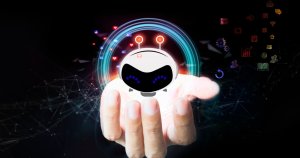
Artificial Intelligence (AI) chatbots are not a recent technology that enters the markets now. Their history dates to the 1960s with the first AI chatbot of its kind by Joseph Weisenbaum, a professor at the Massachusetts Institute of Technology. Today, technology is much more advanced, enabling businesses to improve communication with customers and business processes.
The pandemic opened the door for the AI chatbots to be helpful in solving such major challenges as face-to-face communication between customers and employees, the need to decrease the fixed costs, and the lack of staff when reopening, therefore were adopted fast and successfully by various businesses in almost all industries. In 2020, Gartner named digital self-service as the core activity businesses needed to maintain their business and recover. Chatbots were listed in the top 5 solutions to implement.
According to a study by Salesforce, 77% of customers say that AI chatbots will positively transform their expectations of companies in the next 5 years. This means that the software solution will continue to be one of the main tools for automating the overall customer service and customer experience.
 A common chatbot definition is that is a software solution implemented on a website, in a messenger, in a mobile application, or else online providing users with information through text, images, video, audio, links, and more. The artificial intelligence (AI) chatbot simulates a human conversation by recognizing the message received by a user and providing the appropriate response provided by the business. AI chatbots can perform a variety of tasks from answering frequently asked questions to automate reservations, and service inquiries, gathering customer information, questionnaires, and more.
A common chatbot definition is that is a software solution implemented on a website, in a messenger, in a mobile application, or else online providing users with information through text, images, video, audio, links, and more. The artificial intelligence (AI) chatbot simulates a human conversation by recognizing the message received by a user and providing the appropriate response provided by the business. AI chatbots can perform a variety of tasks from answering frequently asked questions to automate reservations, and service inquiries, gathering customer information, questionnaires, and more.
AI chatbots are more complex, interactive, and personalized than basic chatbots, in which information is provided through pre-set information cards, buttons, and links. Smart digital assistants provide a conversational experience, offer more information, and therefore perform more tasks and may have more functionalities. Conversational AI can be as impressive as the business creates it, and its essence is to “learn” from each user’s communication.
The AI chatbot is an industry-specific tool that helps businesses improve communication with customers through 24-hour self-service, saving time and resources, optimizing staff performance, and many other benefits. The AI chatbot works completely independently and does not need staff support after being trained well for the questions that the business wants to have answers to, and customers receive them instantly.
 AI chatbots are a technology used by many different businesses because of their ability to optimize business processes, automate routine tasks and customer service, free staff from answering frequently asked customer questions, open another marketing and sales channel, and keep visitors on the business website. For these and other reasons, in April’22, CBInsights published research, according to which among the top 12 customer service technologies, AI-enabled chatbots were placed on the top as the first choice as a technology that businesses must prioritize today: “The Covid-19 pandemic has made AI-enabled chatbot solutions essential for brands and retailers to manage record volumes of customer service requests. Most AI-enabled chatbots can automatically answer 60% to 70% of requests.”
AI chatbots are a technology used by many different businesses because of their ability to optimize business processes, automate routine tasks and customer service, free staff from answering frequently asked customer questions, open another marketing and sales channel, and keep visitors on the business website. For these and other reasons, in April’22, CBInsights published research, according to which among the top 12 customer service technologies, AI-enabled chatbots were placed on the top as the first choice as a technology that businesses must prioritize today: “The Covid-19 pandemic has made AI-enabled chatbot solutions essential for brands and retailers to manage record volumes of customer service requests. Most AI-enabled chatbots can automatically answer 60% to 70% of requests.”
Chatbots over the past year have become a mandatory element on the websites and Messenger accounts of many businesses. Finally, businesses also began to use chatbots for their internal needs – communication with staff, training, Human Resources, and more.
In the next years, the trend is that more businesses will implement a chatbot on their website and direct users’ traffic from all social channels to it so that the website can be the main place for communication and information, where the business is in full control. According to a study by Juniper Research from 2020, 43% of existing chatbots are on a website and their use is expected to increase in the next years.
![]()
Human conversation is not an easy process for a chatbot with AI to reproduce, which is why chatbots use some principles of natural language:
- Natural Language Processing (NLP) – Natural language processing is used to separate user input into sentences and words. It also standardizes the text through a series of techniques, such as converting it all to lowercase or correcting spelling mistakes before determining if the word is an adjective or a verb – this is a stage where other factors such as emotions and feelings are considered.
- Natural Language Understanding (NLU) – Natural language understanding helps the chatbot to understand what the user has said using language objects such as synonyms and topics. These are then used in conjunction with algorithms or rules to build dialogues that tell the chatbot how to respond.
- Natural Language Generation (NLG) – Providing a meaningful, personalized experience beyond the pre-set answers. This allows the chatbot to search data in repositories, including third-party databases, and use that information to create a response.
Conversational AI allows businesses to create much more sophisticated dialogue systems, using specific business information to deliver a realistic and engaging conversation.
(Source: Artificial Solutions)
The functionalities of each specific chatbot depend on what the business assigns it to do, where it will be implemented, and with whom it will communicate – with clients, partners, or staff.
AI chatbot technology involves analyzing and understanding what a person is asking, understanding the meaning of words and sentences to interact with people. The AI chatbot identifies asked questions according to the available content in the database and provides a relevant answer. The AI module activates as soon as the client asks a question and provides an answer according to the specific topic. The more customers ask, the smarter the conversational AI becomes, and the more topics and questions it can manage, 24/7, without the need of the staff.
 Collecting, structuring, and analyzing customer questions is the first step to automation and the most important functionality for the AI module performance. It helps the business gradually build a database with topics and answers and it turns customers’ questions into data.
Collecting, structuring, and analyzing customer questions is the first step to automation and the most important functionality for the AI module performance. It helps the business gradually build a database with topics and answers and it turns customers’ questions into data.
The AI chatbot helps the company and the employees:
- Improve the quality of service and support,
- Increase efficiency,
- Predict trends among the customers’ search and interest,
- Improve operations,
- Improve management, marketing and sales,
- Interacting with customers via messaging to help with loyalty,
- Opportunities for using this technology to drive revenue.
 AI chatbots are software solutions with a focus on business tasks, customer service and support. AI virtual assistant software acts more like a personal assistant that helps with daily tasks. AI chatbots are a more simple solution with a narrower range of functionalities than AI virtual assistants.
AI chatbots are software solutions with a focus on business tasks, customer service and support. AI virtual assistant software acts more like a personal assistant that helps with daily tasks. AI chatbots are a more simple solution with a narrower range of functionalities than AI virtual assistants.
Umni use AI digital assistant as a synonymous of AI chatbot to emphasize the AI assistance part of the AI chatbot, as often people think about chatbots as a basic solution that is navigated only by scrolling over pictures and text and clicking buttons, but it is much more than that. Businesses can use it to improve communication with customers and employees, save time and resources, and increase sales by using conversational AI as a major part of their chatbot.
 There are no strict rules and models for creating an AI chatbot, as each chatbot serves the specifics of the business itself and its customers, but here are some good tips for the first steps in planning:
There are no strict rules and models for creating an AI chatbot, as each chatbot serves the specifics of the business itself and its customers, but here are some good tips for the first steps in planning:
- The main purpose of the AI chatbot must be defined
First, it’s important to define the main business goals for starting such project. It must be decided what functionalities will be needed to reach these goals, keeping in mind the time and budget needed for this project. It is very important after deciding what the main goal of the project will be, to continue its development with the goal in mind. A thorough analysis of customer behavior will guide further upgrades and development of the AI chatbot.
- The AI chatbot is a long-term project
Another especially important thing is that the chatbot is not a plug-and-play solution. A good chatbot can start at a basic level when users just click on the buttons in it, but this is the stage where feedback is collected on how users use it and what they are looking for to identify the future direction of chatbot development. Chatbots are long-term projects that require attention, analysis, and upgrades so that one day a business can have a fully developed smart digital assistant. Also, first, plan the whole AI chatbot project and after that focus on the implementation by phases, this will allow you to gain experience in working with chatbot and understanding the customer behavior in it, which can give great ideas for further development of the chatbot and its functionalities. You must be sure that the technology for AI chatbot development used by your team or partners will be suitable for its long-term growth.
- Take control of the whole process of creating an AI chatbot
Ensure that the AI chatbot project is well-coordinated to not waste needless time and business resources. It is necessary to choose one person (in smaller businesses) or preferably a team to commit to this project. Thus, certain people will focus on ongoing monitoring of the AI chatbot work and customer behavior in it, regularly making corrections or adding relevant information, upgrading new AI chatbot functionalities, and solving issues to improve it.
- Launching the AI chatbot is just the first step
The AI chatbot needs to be constantly trained to get smarter because the main goals of every business are better customer support and increasing customer satisfaction. At the same time, it is important for the chatbot to be promoted on different social media channels so that customers know of its existence and use it. The chatbot should grow and develop dynamically while analyzing statistics about customer behavior, what customers are looking for, when they are looking for it, and what their problems and interests are. The AI chatbot must be part of all business, marketing and sales strategies and take its well-planned place in the digital ecosystem of the business.
Remember, the chatbot is a dynamic software solution that is a combination of technologies that come together to accomplish tasks, not a complete standalone software installed on someone’s computer.
If you want someone to help you successfully deal with all these dynamics, this is for sure a job for an AI chatbot specialized providers, such as the platform of Umni, where you can create your own AI chatbot, manage it and train it for the specifics and needs of your business without any technical knowledge and skills.
 The content is entirely managed by the business. The business adds relevant information to the AI chatbot, provides answers on business topics, and makes changes at any time throughout the content, to keep the information up to date and provide relevant answers to customers. There is no danger that artificial intelligence will decide for itself what to answer if it is not submitted by the business itself.
The content is entirely managed by the business. The business adds relevant information to the AI chatbot, provides answers on business topics, and makes changes at any time throughout the content, to keep the information up to date and provide relevant answers to customers. There is no danger that artificial intelligence will decide for itself what to answer if it is not submitted by the business itself.
It is wrong to categorize chatbots as “dumb” when they fail to answer a customer question – they just need time and data, same as a new employee. The challenge for using AI is the need for the business to provide a large amount of data – in the case of chatbots, this is collected customer questions so that the AI chatbot can be trained to work well. For this reason, the advice to any business that thinks long-term in this direction is to start this process now so that it can have a working solution in 6 months or a year.
It is also recommended to work with an AI chatbot service provider that has industry expertise. One such company is Umni, which no-code platform helps businesses turn customer questions into industry-focused trained conversational AI without any technical skills for their website AI chatbot.
 The AI chatbot is an industry-specific tool that helps businesses improve customer communication, save time and resources, optimize staff performance, open another marketing and sales channel, keep users on the website, and many other benefits.
The AI chatbot is an industry-specific tool that helps businesses improve customer communication, save time and resources, optimize staff performance, open another marketing and sales channel, keep users on the website, and many other benefits.
The first steps in planning an AI chatbot are knowing what its purpose is and planning for a long-term strategy, remembering that you need to constantly maintain and improve it, so it can help the business to succeed.
AI chatbot is one of the fastest-growing and most popular technologies that many different businesses have been using for a long time, and if you want to have this solution for your business, now is the time. Umni provides a suitable platform to start working on your AI chatbot without any technical knowledge and skills.